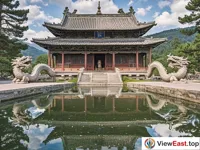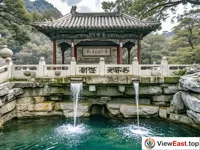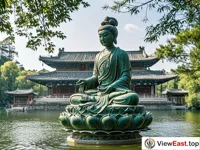







A. Scenic Introduction
Jin Temple: A Testament to History
Nestled at the foot of Xuanwo Mountain, 25 kilometers southwest of Taiyuan City, Shanxi Province, China, Jin Temple is the oldest existing imperial sacrificial garden in China and a cradle of Jin culture. It is a place where natural beauty and historical significance are interwoven, making it a treasure trove of cultural heritage.
Historical Culture
The history of Jin Temple dates back to the Western Zhou Dynasty, initially constructed to commemorate the founding lord of the Jin state, Tang Shuyu. Through successive dynasties such as the Northern Qi, Sui, Tang, Song, Yuan, Ming, and Qing, the temple has been a site of veneration and has expanded into a historical landmark that blends natural scenery with cultural artifacts.
Natural Landscapes
The natural landscapes of Jin Temple are characterized by the waters of the Jin River, which originates from the three springs: the Nanlao Spring, Shanli Spring, and Yuzhao Spring. The crystal-clear springs are perennial, surrounded by ancient trees and lush greenery that complement the ancient architecture, creating a captivating scene.
Cultural Features and Unique Experiences
The cultural essence of Jin Temple is reflected in its exquisite architecture and valuable cultural relics. Ancient buildings such as the Holy Mother Hall, Dedication Hall, and the Tang Stele Pavilion display the superb craftsmanship of ancient Chinese architecture. Additionally, the temple houses a wealth of inscriptions, sculptures, and murals, making it an invaluable resource for the study of ancient Chinese art.
Stories and Metaphors
Jin Temple is akin to a voluminous historical tome, with each page detailing the splendor and vicissitudes of the Jin state. It is more than a scenic spot; it is a place where one can deeply experience the charm of ancient Chinese culture.
B. Travel Advice
Transportation Routes
Visitors can fly or take high-speed trains to Taiyuan and then transfer to public buses or taxis to reach Jin Temple. The public transportation system in Taiyuan is well-developed, providing easy access to the temple.
Tourist Facilities
The temple complex is well-equipped with facilities, clear signage, and professional guide services. There are various hotels and restaurants around the temple to accommodate different visitors' needs. Moreover, Taiyuan is known for its good security, ensuring a worry-free visit.
Accommodation and Local Cuisine
Taiyuan's cuisine is primarily noodle-based, with dishes like Daoxiao noodles and cat's ear pasta that are must-try local specialties. Visitors can enjoy these authentic Shanxi dishes at restaurants near Jin Temple.